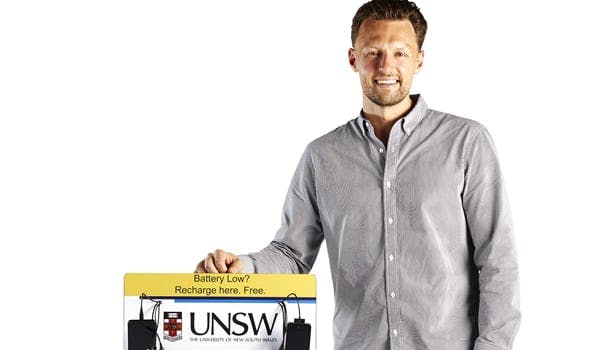If Chargebar’s Jonathon Tanner has his way, you’ll never be caught out with a flat phone battery again.
What started as a flat phone on a night out, has now turned into a viable business with charging units set up everywhere from university campuses, cafés, and hospitals to Qantas airport lounges.
We spoke to Tanner about what drives this very unique business.
What made you decide to start your own business?
My background’s been [varied] across industries so it was everything from luxury boats to mining to retail and media. The frustration that comes with that type of work is that after a while you get a burning desire to get your own hands dirty. While we were doing a lot of strategic stuff, I wanted to really get in and have a go at the implementation side of business. Also, my whole career I’ve always had a keen interest in anything entrepreneurial and having done years in consulting, when the opportunity arose, I jumped at it.
How did the idea for Chargebar come about?
It all started in a bar. I was with a mate and both our phones were dead, so we couldn’t connect with the people we were meeting up with. The next day my mate and I were talking about it, and I thought that there had to be a solution. I started doing some research and discovered there was a concept over in the US, and one thing led to another and we ended up signing a distribution agreement with a US company.
We weren’t the first ones to come up with the concept globally, but like the company in the US we had identified the consumer need for it pretty early on. Venues think about it like Wi-Fi in terms of customer service now. It’s really good customer service, and very effective in drawing foot traffic into a particular area. Put into a retail or hospitality environment, it’s a good way to drive sales.
What challenges did you face getting the business off the ground?
Like any startup, the ongoing concern at first is cash flow and making ends meet, and shaping your business model around that. We originally started the business as a media business – I had a lot of background in media consulting, so I understood that market quite well. We thought the value of the concept was in the media, because undoubtedly when someone plugs their phone in you’ve got a very captive audience for 15 or 20 minutes while they wait for their phone to recharge. We had these units with digital touchscreens on them, so we would give them to certain venues for free and sell advertising off the back of them, but that model had its challenges.
It was quite capital-intensive as we were paying for the hardware, and at the time those costs were quite high. It also meant that we had to be pretty selective in what venues we chose. We had other small venues calling us asking for a unit and had to refuse them. We soon realised that the value of the product lay in the charging service than the advertising, so we made a substantial pivot and started selling the units outright to the venues and letting the venue itself brand the front of the charging station so it fit with the venue. That change has catapulted us.
Potentially once we have more penetration across the country there could be media play there, but for the time being our focus is on acquiring as many venues as possible in the shortest possible timeframe.
Companies like Qantas are using Chargebars – how have you gotten big companies on board?
Again, one of the early challenges we faced was working out our selling technique and how to go about acquiring the bigger venues. When we started we were boiling the ocean, targeting as many of the big companies as we could. What we’ve moved into doing now is taking more of a channel focus. One of the markets we identified was education, with universities, TAFEs, and libraries. That’s been incredibly successful, almost 50 per cent of Australian universities now have a Chargebar.
Now we’ve taken that strategic focus into the medical channel, looking at hospitals and medical centres. We’ve also taken on another salesperson who’s looking at hospitality, so hotels and the like. When you do that, you tend to be able to identify the needs of each particular channel as much as possible. Then when you drive penetration in each industry and get some significant names on board, some of the bigger chains start to take notice.
I really like the hospital channel because a lot of people find themselves in a hospital unexpectedly and there’s never a more important time to have your phone charged so you can contact your loved ones, so that’s a really rewarding channel. That started with a hospital in Canberra finding us online and getting in touch to put them all across the hospital. That kind of industry focus is what we’re going to continue to do.

